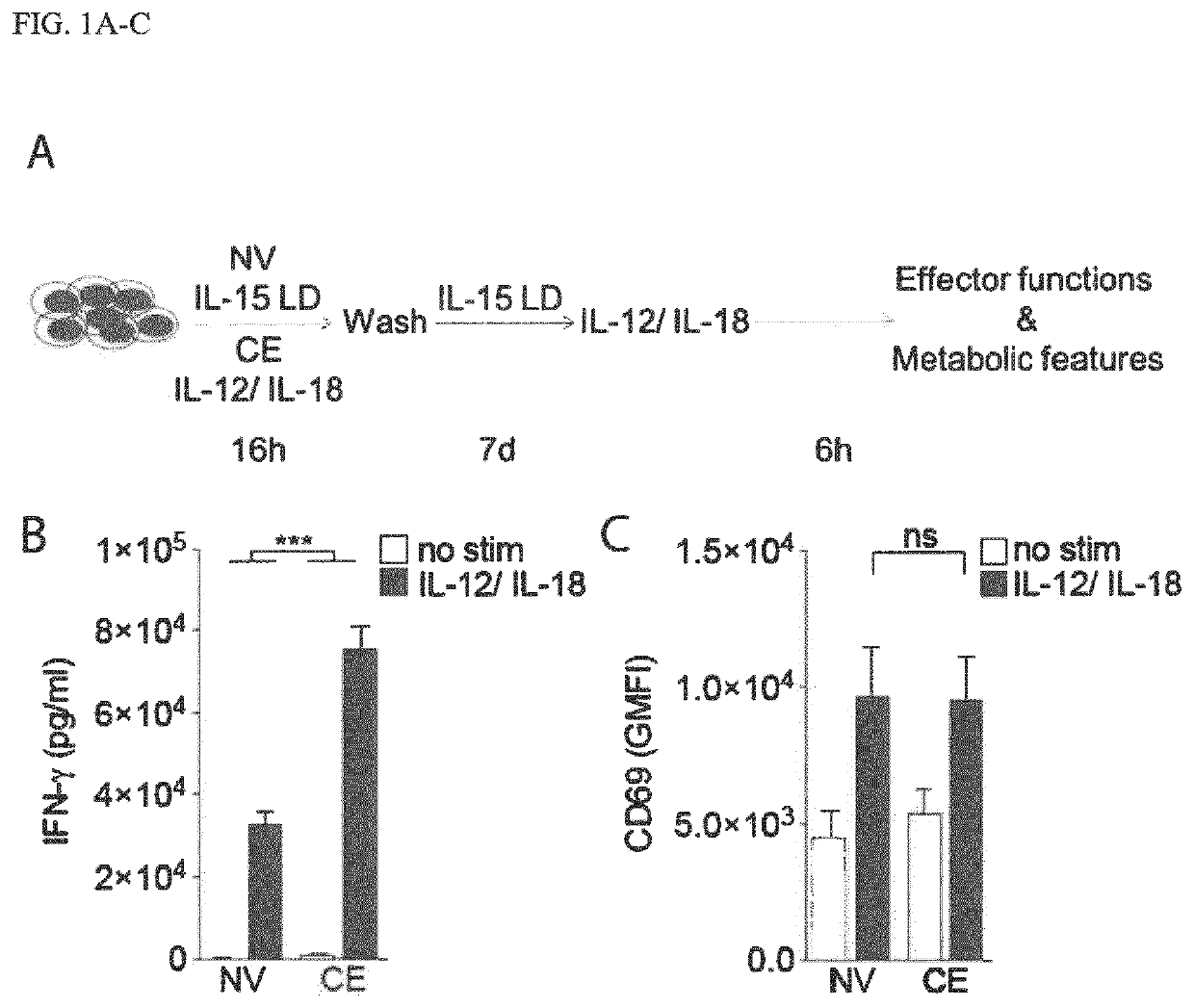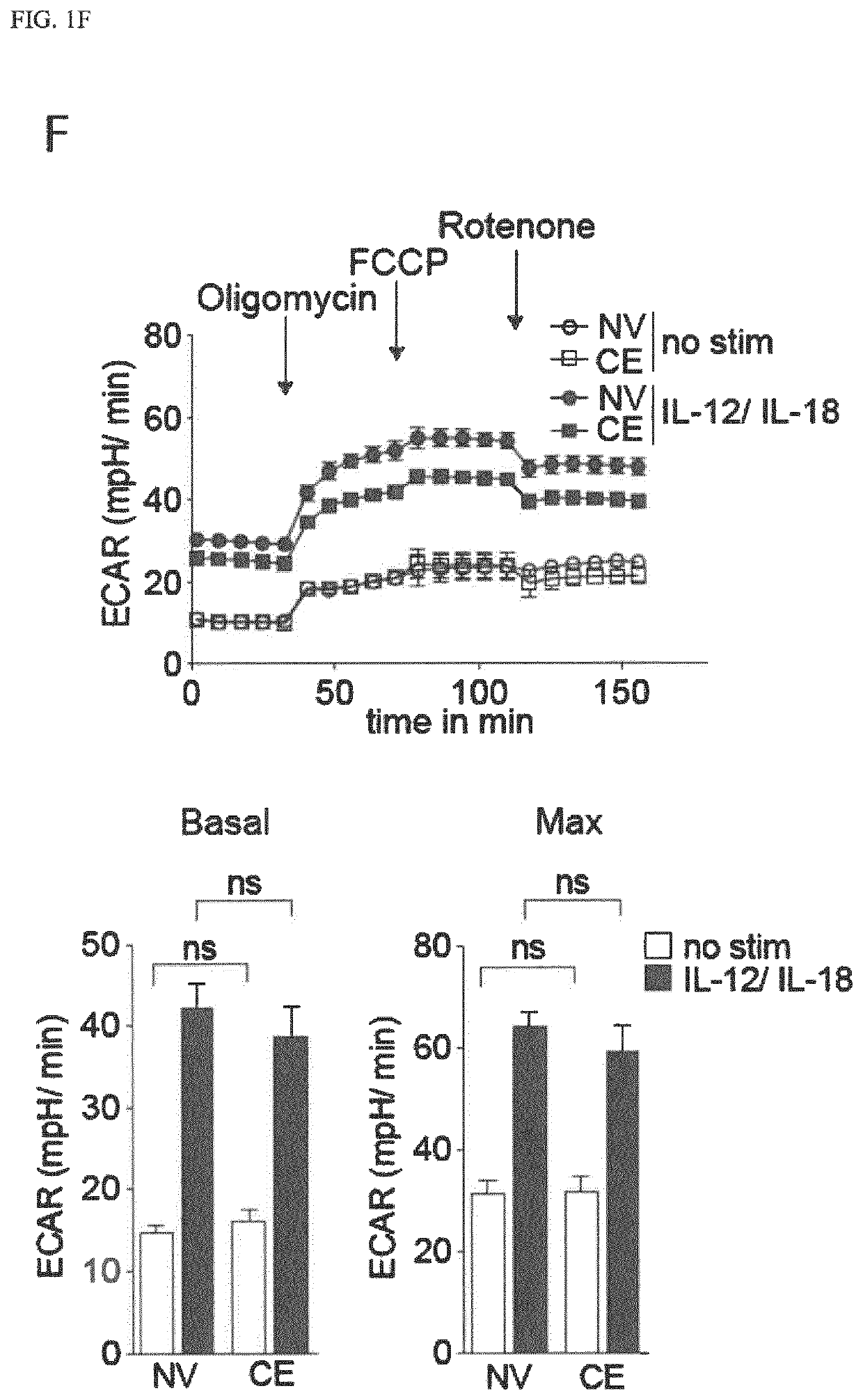Cell therapy methods
a cell therapy and method technology, applied in the field of cell therapy methods, can solve the problems of increasing risk, significant morbidity and mortality, and vulnerable transplant recipients
- Summary
- Abstract
- Description
- Claims
- Application Information
AI Technical Summary
Benefits of technology
Problems solved by technology
Method used
Image
Examples
example 1
Cytokine-Enhanced NK Cells Similarly Rely on Glycolysis for IFN-γ Production
[0273]Enhanced recall responses of cytokine-enhanced (CE) NK cells reflect a promising feature for immune cell therapy against cancer. If and how CE NK cell metabolism underpins cytokine production, target cell clearance and proliferation remains unknown. To elucidate these key features of CE NK cells, the inventors used an established in vitro CE NK cell model that allowed comparison of naive (NV) vs. CE NK cells. Briefly, the inventors primed freshly isolated human NK cells with IL-12 and IL-18 (IL-12 / IL-18) for 16 h, followed by a rest period in low dose IL-15 (IL-15 LD) to support survival. After 7 days of rest, features of NV vs. CE NK cells upon stimulation were compared (FIG. 1A). In line with previous data, priming of NK cells with IL-12 / IL-18 augmented their capacity to produce IFN-γ upon re-stimulation (FIG. 1B). Of note, NK cells were similarly activated upon stimulation, as indicated by CD69 expr...
example 2
CE NK Cells are Characterized by High Levels of Cell-Surface CD71 and Rapid Cell Proliferation
[0276]To further characterize the metabolic profile of NV vs. CE NK cells, the inventors analyzed surface expression of the nutrient transporters CD98 and CD71 reported to be upregulated on activated NK cells. Upon stimulation, a slight and comparable increase in CD98 expression on both NK cell subsets was observed (FIG. 2A). In contrast, upregulation of the transferrin receptor CD71 was much greater on CE vs. NV NK cells, both when expressed as GMFI and percentage of positive cells (FIG. 2B). Increased cell surface expression of CD71 was reflected by an overall greater cellular abundance of CD71 protein as assessed by immunoblot analysis of whole cell lysates (FIG. 2C). To test whether differential cell surface expression of CD71 could also be driven by NK cell stimulation via activating receptors, both subsets were stimulated with HLA-deficient target cells (K562 cell line). Similar to cy...
example 3
ated Iron Uptake and Dietary Iron Availability Impact NK Cell Function
[0279]Recently, a mutation in the TFRC gene (TFRCY20H / Y20H) has been shown to impair B and T cell function, causing a primary immunodeficiency (PID). The mutation affects receptor-mediated endocytosis and compromises CD71-mediated iron uptake both in human cells and when introduced into mice. NK cell numbers in patients harboring this mutation are normal, however, functional properties have not been previously assessed. To test whether CD71 function and NK cell proliferation are linked, the inventors assessed CFSE dilution in IL-1S LD and IL-12 / IL-18-stimulated wild type (WT) and TfrcY20H / Y20H murine NK cells, ex vivo. These experiments revealed a striking lack of IL-15 LD and IL-12 / IL-18-induced proliferation among NK cells harboring the Tfrc mutation (FIG. 3A).
[0280]Given this strong phenotype, the inventors wondered whether mild iron deficiency might be sufficient to cause NK cell dysfunction. To explore this n...
PUM
| Property | Measurement | Unit |
|---|---|---|
| time | aaaaa | aaaaa |
| time period | aaaaa | aaaaa |
| time period | aaaaa | aaaaa |
Abstract
Description
Claims
Application Information
 Login to View More
Login to View More - R&D
- Intellectual Property
- Life Sciences
- Materials
- Tech Scout
- Unparalleled Data Quality
- Higher Quality Content
- 60% Fewer Hallucinations
Browse by: Latest US Patents, China's latest patents, Technical Efficacy Thesaurus, Application Domain, Technology Topic, Popular Technical Reports.
© 2025 PatSnap. All rights reserved.Legal|Privacy policy|Modern Slavery Act Transparency Statement|Sitemap|About US| Contact US: help@patsnap.com



